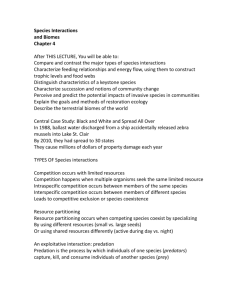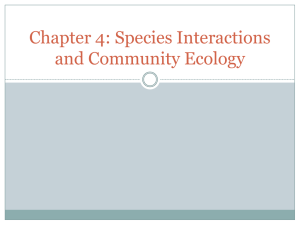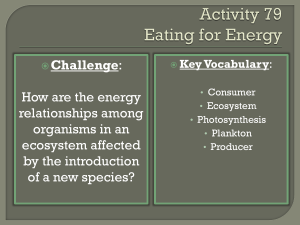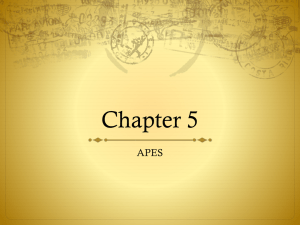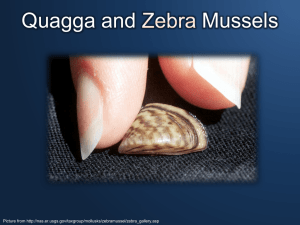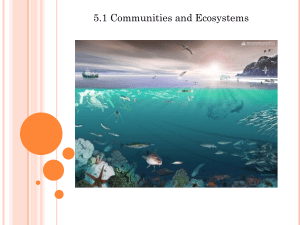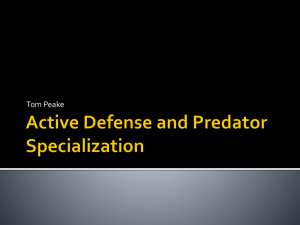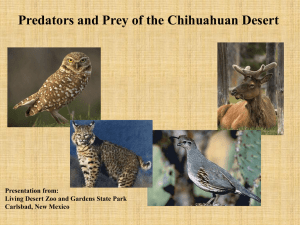Species Interactions and Community Ecology
advertisement
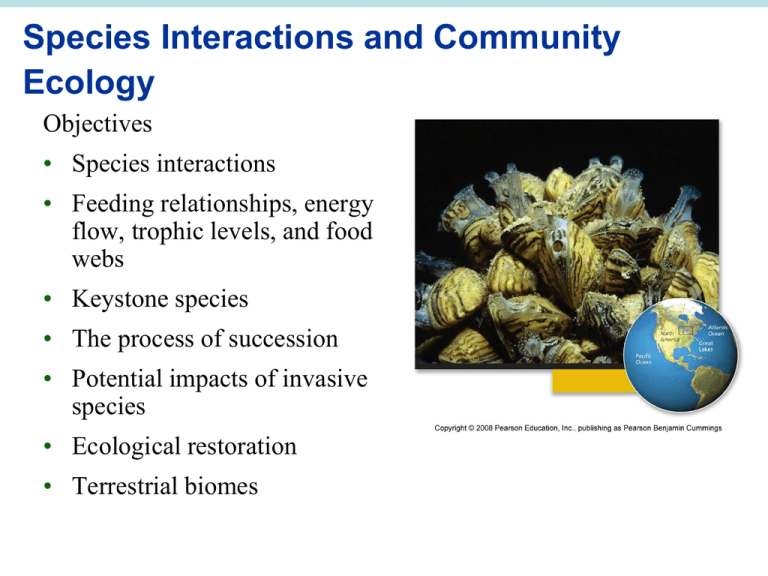
Species Interactions and Community Ecology Objectives • Species interactions • Feeding relationships, energy flow, trophic levels, and food webs • Keystone species • The process of succession • Potential impacts of invasive species • Ecological restoration • Terrestrial biomes Case Study: Black and white and spread all over • Small, black and white shellfish native to western Asia and eastern Europe • Introduced in 1988 to Lake St. Clair, Canada, in discharged ballast water • By 1994, zebra mussels had invaded all 5 Great Lakes, the Mississippi river, 19 U.S. states, and 2 Canadian provinces. - No natural predators, competitors, or parasites • These mussels cost the U.S. economy hundreds of millions of dollars of damage to property each year. - They also cause enormous ecological damage. Zebra Mussel Question/ Schema Activator Species interactions • Species interactions are the backbone of communities. Mutualism • Trees and mycorrhizal fungi: Mycorrhizal fungi live in and around the roots of most plants. In exchange for sugars and simple carbohydrates, the mycorrhizal fungi absorb and pass on minerals and moisture required for the plant's growth. • Bees pollinating flowers: A flower provides a bee with pollen and nectar and the bee pollinates the flower as it moves from flower to flower. Competition occurs with limited resources • Competition: relationship where multiple organisms seek the same limited resources they need to survive - Generally subtle, not outright fighting - Resources = Food, water, space, shelter, mates, sunlight, etc. • Intraspecific competition: between members of the same species • Interspecific competition: between members of 2 or more species • Effective competitors can completely exclude other species - i.e., Zebra mussels displace native mussels - But some species can coexist by using different resources Resource partitioning In competitive relationships, each participant has a negative effect on the other participant. • To reduce competition, species can use a resource in slightly different ways. • Resource partitioning: when species divide shared resources by specializing in different ways - Examples: one species is active at night, another in the daytime; one species eats small seeds, another eats large seeds Size of a niche: The part of a fundamental niche that a species occupies is called it’s realized niche. For example, the Cape May warbler —Spends summers in the northeast US —Nests in midsummer —Eats small insects —Searches for food high up in spruce trees at the tips of branches The entire range of resource opportunities an organism is potentially able to occupy within an ecosystem is called it’s fundamental niche. Each warbler species feeds at a different height in the forest Predation • Exploitative interactions: a type of interaction where one species benefits while another is harmed 1. Predation, 2. parasitism, 3. herbivory • Predation: process by which individuals of one species (predators) capture, kill, and consume individuals of another species (prey) - Structures food webs - Influences community composition by determining numbers of predators and prey An example of predation: zebra mussels • Zebra mussels prey on zooplankton. - Zooplankton decrease in lakes with zebra mussels. • Zebra mussels prey on phytoplankton. - Compete with zooplankton • Zebra mussels are becoming prey for some North American predators. - Ducks, fish, muskrats, crayfish Predation can drive population dynamics • Increased prey populations increase predators. - Predators survive and reproduce. • Increased predator populations decrease prey. • Decreased prey populations cause starvation of predators. • Decreased predator populations increase prey populations. Predation has evolutionary ramifications • Natural selection leads to evolution of adaptations that make predators better hunters. • Individuals who are better at catching prey… - Live longer, healthier lives - Take better care of offspring • Since prey are at risk of immediate death… - They develop elaborate defenses against being eaten Parasites exploit living hosts • Parasitism: a relationship in which one organism (parasite) depends on another (host) for nourishment or other benefit, while simultaneously harming the host - Usually does not immediately kill the host Some species are free-living, and infrequently contact their hosts. Cuckoos and cowbirds lay eggs in other birds’ nests. Many species live within the host. Disease, tapeworms Other species live on the exterior of their hosts. Sea lamprey Coevolution • Coevolution: evolution of hosts and parasites in response to each other - They become locked in a duel of escalating adaptations. - Has been called an “evolutionary arms race” - Each evolves new responses to the other - It may not be beneficial to the parasite to kill its host. Herbivores exploit plants • Exploitation in which animals feed on the tissues of plants - Widely seen in insects - May not kill the plant, but affects its growth and survival • Defenses against herbivory include: - Toxic or distasteful chemicals - Thorns, spines, or irritating hairs Mutualists help one another • Mutualism: a relationship in which interacting species benefit from one another • Symbiosis: mutualism in which the organisms live in close physical contact - Plant roots and fungi - Coral polyps and algae (zooxanthellae) • Pollination: bees, bats, birds, and others transfer pollen from one flower to another, fertilizing its eggs - Species may encounter each other infrequently. - Bees pollinate 73% of our crops. Plant roots and fungi Coral polyps and algae (zooxanthellae) bees, bats, birds, and others transfer pollen from one flower to another, fertilizing its eggs Species Interactions Questions Ecological communities • Community: an assemblage of species living in the same place at the same time - Members interact with each other. - These interactions determine the composition, structure, and function of the community. • Community ecologists: people interested in: - How species coexist and relate to one another - How communities change - Why patterns exist Energy passes among trophic levels • One of the most important species interactions is who eats whom. • Matter and energy move through the community. • Trophic levels: rank in the feeding hierarchy - Producers - Consumers - Detritivores and Decomposers Trophic levels • Autotrophs (“self-feeders”): organisms that capture solar energy for photosynthesis to produce sugars - Green plants, cyanobacteria, algae • Primary consumers: organisms that consume producers and comprise the second trophic level - Herbivores such as deer and grasshoppers • Secondary consumers: prey on primary consumers and comprise the third trophic level - Carnivores (wolves, birds) that consume meat • Tertiary consumers: predators that feed at higher trophic levels - Hawks, owls Detritivores and decomposers • Organisms that consume non-living organic matter • Detritivores: scavenge waste products or dead bodies - Millipedes • Decomposers: break down leaf litter and other non-living material - Fungi, bacteria - Enhance topsoil and recycle nutrients Energy decreases at higher trophic levels • Most energy organisms use is lost as waste heat through respiration. - Less and less energy is available in each successive trophic level. - Each level contains only 10% of the energy of the trophic level below it. • With less energy available, there are far fewer organisms at the highest trophic levels. A human vegetarian’s ecological footprint is smaller than a meat-eater’s footprint. Pyramids of energy, biomass, and numbers Food webs show relationships and energy flow • Food chain: a linear series of feeding relationships - Ecological systems are far more complex than this. • Food web: a visual map of feeding relationships and energy flow - Includes many different organisms at all the various levels - Greatly simplified; leaves out the majority of species FOOD WEB Feeding relationships and Energy Flow Question Some organisms play big roles • Keystone species: has a strong or wide-reaching impact far out of proportion to its abundance • Removal of a keystone species has substantial ripple effects. - Alters the food web Keystone species can change communities • Large-bodied secondary or tertiary consumers are often keystone species. - Extermination of wolves led to increased deer populations, which led to overgrazed vegetation and changed forest structure. • Ecosystem engineers: physically modify the environment and exert strong community-wide effects - Beaver dams, prairie dogs, fungi Keystone Species Question Communities respond to disturbances • Communities experience many types of disturbance. - Removal of keystone species, spread of invasive species, natural disturbances - Human impacts cause major changes • Resistance: community that resists change and remains stable despite the disturbance • Resilience: a community changes in response to a disturbance, but later returns to its original state - Some communities may be permanently changed. Primary succession • Succession: the predictable series of changes in a community following a disturbance • Primary succession: disturbance eliminates all vegetation and/or soil life - A community is built from scratch - Glaciers, drying lakes, volcanic lava • Pioneer species: the first species to arrive in a primary succession area (i.e., lichens) - New organisms arrive, increasing vegetation and diversity Secondary succession • Secondary succession: a disturbance dramatically alters, but does not destroy, all local organisms - Parts of the previous community remain and serve as “building blocks.” - Fires, hurricanes, farming, logging Community change is variable • Climax community: the community resulting from successful succession - Remains stable until another disturbance restarts succession • Community change is variable and unpredictable. - Conditions at one stage may promote progression to another stage. - Organisms, through competition, may inhibit progression to another stage. - Other factors (e.g., soil conditions) also help determine communities. Succession Questions Invasive species threaten communities • Invasive species: non-native (exotic) organisms that spread widely and become dominant in a community - Can substantially alter a community - Growth-limiting factors (predators, disease, etc.) are removed or absent - They have major ecological effects - Fish introduced for sport outcompete and exclude native fish • Some species help people (i.e., European honeybee). Two invasive mussels Zebra mussels impact other species, either positively or negatively. Controlling invasive species • Techniques to control invasive species: - Remove manually - Toxic chemicals - Drying them out - Depriving of oxygen - Introducing predators and diseases - Stressing them - Heat, sound, electricity, carbon dioxide, ultraviolet light Prevention, rather than control, is the best policy. Invasive Species Question Changed communities need to be restored • Humans have altered Earth’s landscape to such a degree, that no area is truly pristine. • Ecological restoration: returning an area to unchanged conditions - Informed by restoration ecology: the science of restoring an area to the condition that existed before humans changed it - It is difficult, time-consuming, expensive - Best to protect natural systems from degradation in the first place Restoration efforts • Prairie Restoration - Native species replanted and invasive species controlled http://www.prairieresto.com/mission.shtml • The world’s largest project: Florida Everglades - Depletion caused by flood control practices and irrigation - Populations of wading birds dropped 9095%. - It will take 30 years and billions of dollars to undo dams and diversions. - Restoring ecosystem services will prove economically beneficial. http://www.dep.state.fl.us/secretary/everglades/ Restoration Ecology Question Earth’s biomes • Around the world, communities share strong similarities. • Biome: a major regional complex of similar communities recognized by: - Plant type - Vegetation structure A variety of factors determine the biome • The biome in an area depends on a variety of abiotic factors. - Temperature, precipitation, ocean and air circulation, soil • Climatograph: a climate diagram showing an area’s temperature and precipitation Similar biomes occur at similar latitudes. http://www.ucmp.berkeley.edu/exhibits/biomes/index.php http://www.bcscience.com/bc10/docs/puzzles/section01_1_puzzle/index.html Aquatic systems have biome-like patterns • Various aquatic systems have distinct communities. - Coastlines, continental shelves - Open ocean, deep sea - Coral reefs, kelp forests - Coastal systems (marshes, mangrove forests, etc.) - Freshwater systems (lakes, rivers, etc.) • Aquatic systems are shaped by: - Water temperature, salinity, and dissolved nutrients - Wave action, currents, depth - Substrate type and animal and plant life Biome Question Temperate deciduous forest • Deciduous trees lose their leaves each fall and remain dormant during winter • Mid-latitude forests in Europe, East China, Eastern North America • Fertile soils • Forests: oak, beech, maple Temperate grasslands • More extreme temperature difference between winter and summer • Less precipitation • Also called steppe or prairie - Once widespread throughout parts of North and South America and much of central Asia - Much was converted for agriculture - Bison, prairie dogs, antelope, and ground-nesting birds Temperate rainforest • Coastal Pacific Northwest region • Great deal of precipitation • Coniferous trees: cedar, spruce, hemlock, fir • Moisture-loving animals - Banana slug • The fertile soil is susceptible to erosion and landslides. • Overharvesting has driven species to extinction and ruined human communities. Tropical rainforest • Central and South America, southeast Asia, west Africa • Year-round rain and warm temperatures • Dark and damp • Lush vegetation • Highly diverse species, but at low densities • Very poor, acidic soils • Nutrients contained in plants Tropical dry forest • Tropical deciduous forest • India, Africa, South America, northern Australia • Wet and dry seasons • Warm, but less rainfall • Converted to agriculture • Erosion-prone soil Savanna • Tropical grassland interspersed with trees • Africa, South America, Australia, India • Precipitation only during rainy season • Water holes • Zebras, gazelles, giraffes, lions, hyenas Desert • Minimal precipitation • Some deserts are bare, with sand dunes (Sahara). • Some deserts are heavily vegetated (Sonoran). • They are not always hot. - Temperatures vary widely • Saline soils (“lithosols”) • Nocturnal or nomadic animals • Plants have thick skins or spines. Tundra • Canada, Scandinavia, Russia • Minimal precipitation - Nearly as dry as a desert • Seasonal variation in temperature - Extremely cold winters • Permafrost: permanently frozen soil • Few animals: polar bears, musk oxen, caribou • Lichens and low vegetation with few trees Boreal forest (taiga) • Canada, Alaska, Russia, Scandinavia • Variation in temperature and precipitation • Cool and dry climate - Long, cold winters - Short, cool summers • Poor, acidic soil • Few evergreen tree species • Moose, wolves, bears, migratory birds Chaparral • Mediterranean Sea, California, Chile, and southern Australia • High seasonal - Mild, wet winters - Warm, dry summers • Frequent fires • Densely thicketed, evergreen shrubs Conclusion • Biomes and communities help us understand how the world functions. • Species interactions affect communities. - Competition, predation, parasitism, mutualism • Feeding relationships are represented by trophic levels and food webs. - Keystone species are particularly influential. • Humans have altered many communities. • Ecological restoration attempts to undo the negative changes that we have caused.
